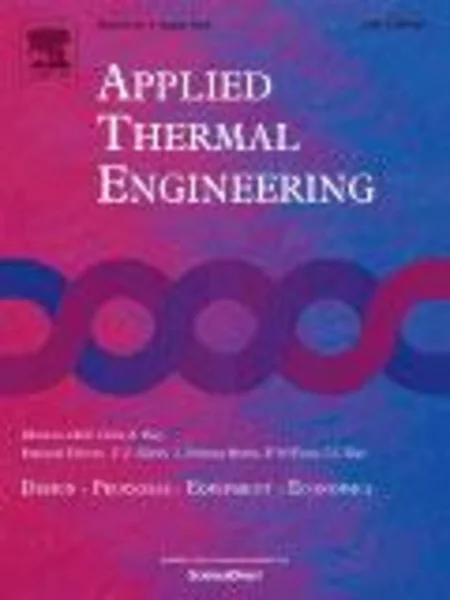-
heat transfer processes in parallel-plate heat exchangers of thermoacoustic devices – numerical and experimental approaches
جزئیات بیشتر مقاله- تاریخ ارائه: 1392/01/01
- تاریخ انتشار در تی پی بین: 1392/01/01
- تعداد بازدید: 670
- تعداد پرسش و پاسخ ها: 0
- شماره تماس دبیرخانه رویداد: -
this paper addresses the issues of heat transfer in oscillatory flow conditions, which are typically found in thermoacoustic devices. the analysis presented concerns processes taking place in the individual “channels” of the parallel-plate heat exchangers (hx), and is a mixture of experimental and numerical approaches. in the experimental part, the paper describes the design of experimental apparatus to study the thermal-fluid processes controlling heat transfer in thermoacoustic heat exchangers on the micro-scale of the individual channels. planar laser induced fluorescence (plif) and particle image velocimetry (piv) techniques are applied to obtain spatially and temporally resolved temperature and velocity fields within the hx channels. the temperature fields allow obtaining the local and global, phase-dependent heat transfer rates and nusselt numbers, and their dependence on the reynolds number of the oscillating flow. the numerical part of the paper deals with the implementation of cfd modelling capabilities to capture the physics of thermal-fluid processes in the micro-scale and to validate the models against the experimental data. a two-dimensional low mach number computational model is implemented to analyse the time-averaged temperature field and heat transfer rates in a representative domain of the hxs. these are derived by integrating the thermoacoustic equations of the standard linear theory into a numerical calculus scheme based on the energy balance. the comparisons between the experimental and numerical results in terms of temperature and heat transfer distributions suggest that the optimal performance of heat exchangers can be achieved when the gas displacement amplitude is close to the length of hot and cold heat exchanger. heat transfer coefficients from the gas-side can be predicted with a confidence of about 40% at moderate acoustic reynolds numbers.
حوزه های تحت پوشش رویداد
مقالات جدیدترین رویدادها
-
استفاده از تحلیل اهمیت-عملکرد در ارائه الگوی مدیریت خلاقیت سازمانی و ارائه راهکار جهت بهبود
-
بررسی تاثیر ارزش وجوه نقد مازاد بر ساختار سرمایه شرکت های پذیرفته شده در بورس اوراق بهادار تهران
-
بررسی تأثیر سطح افشای ریسک بر قرارداد بدهی شرکت های پذیرفته شده در بورس اوراق بهادار تهران
-
بررسی تأثیر رتبه بندی اعتباری مبتنی بر مدل امتیاز بازار نوظهور بر نقد شوندگی سهام با تأکید بر خصوصی سازی شرکت ها
-
تأثیر آمیخته بازاریابی پوشاک ایرانی بر تصویر ذهنی مشتری پوشاک ایرانی (هاکوپیان)
-
نقش میانجی گرایش به کارآفرینی در تبیین رابطه بین نوآوری سازمانی و چابکی سازمانی
-
بررسی تحولات ماگمایی مرتبط با کانی سازی در نشانه های معدنی شمال کبودان (کمپلکس تکنار): شواهد دگرسانی و ژئوشیمی عناصر نادر خاکی (ree)
-
اولویت بندی تعمیر و نگهداری تابلوهای ترافیکی راه ها با استفاده از فرآیند تحلیل سلسله مراتبی
-
علل و اثرات افت تنش های پیش تندگی در سازه های بتنی پیش تنیده
-
مکانیابی پناهگاه های اسکان موقت در راستای کاهش تلفات انسانی بر اثر حملات نظامی (حملات هوایی و موشکی) مورد مطالعه: شهر اهواز
مقالات جدیدترین ژورنال ها
-
مدیریت و بررسی افسردگی دانش آموزان دختر مقطع متوسطه دوم در دروان کرونا در شهرستان دزفول
-
مدیریت و بررسی خرد سیاسی در اندیشه ی فردوسی در ادب ایران
-
واکاوی و مدیریت توصیفی قلمدان(جاکلیدی)ضریح در موزه آستان قدس رضوی
-
بررسی تاثیر خلاقیت، دانش و انگیزه کارکنان بر پیشنهادات نوآورانه کارکنان ( مورد مطالعه: هتل های 3 و 4 ستاره استان کرمان)
-
بررسی تاثیر کیفیت سیستم های اطلاعاتی بر تصمیم گیری موفق در شرکتهای تولیدی استان اصفهان (مورد مطالعه: مدیران شرکتهای تولیدی استان اصفهان)
-
بررسی تأثیر آگاهی از تخلفات مالی انجام شده بر رفتار و ارزشهای اخلاقی حسابداران
-
بررسی نقش میزان تاثیر احساس امنیت اجتماعی در توسعه فرهنگی مناطق شهری (بندرعباس)
-
تأثیر پیامدهای پاندمی کرونا (کووید-19) بر ساختار جمعیتی
-
قواعد و فواید تسعیر اختیاری در بازار اسلامی با انطباق بر فقه المکاسب
-
بررسی ارتباط بین ادراک فضای سیاسی سازمان با رضایت شغلی کارکنان (مطالعه موردی: معاونت فرهنگی و اجتماعی وزارت علوم، تحقیقات و فناوری)




سوال خود را در مورد این مقاله مطرح نمایید :